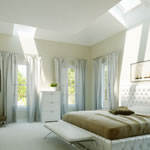Actually getting LEED certification for a new home can cost anywhere between $5,000 to $22,000, sometimes making the prevalent green-building certification unattainable. There are other programs, of course: Passive House, Living Building Challenge, and a handful of local rating systems. But according to St. Louis architect Jeff Day, Active House certification can open green doors for a number of homeowners.
 Jeff Day & Associates Architecture was asked by a client to design an Active House, a program tailored to holistic, sustainable homebuilding through emphases on occupant comfort, renewable energy, and environmental context. Active House-certified homes can be found in Russia and throughout Europe, and some are in the works in Canada, but the house Day worked on is the first of its kind in North America, and it drew immediate attention. “About 2,400 people came to the open house,” he says of the 2,500-square-foot home in Webster Groves, Missouri, a suburb of St. Louis. “The next day we received a half-dozen calls from people who were interested in the natural daylighting and sustainable indoor climate features for their next homes.”
Jeff Day & Associates Architecture was asked by a client to design an Active House, a program tailored to holistic, sustainable homebuilding through emphases on occupant comfort, renewable energy, and environmental context. Active House-certified homes can be found in Russia and throughout Europe, and some are in the works in Canada, but the house Day worked on is the first of its kind in North America, and it drew immediate attention. “About 2,400 people came to the open house,” he says of the 2,500-square-foot home in Webster Groves, Missouri, a suburb of St. Louis. “The next day we received a half-dozen calls from people who were interested in the natural daylighting and sustainable indoor climate features for their next homes.”
St. Louis’s varying climate and weather make it a great candidate to test the new certification in the United States. The average temperature in January is below freezing while much of July tips above 90 degrees Fahrenheit. Day explains that a St. Louis house needs a tight building envelope adaptable to winter and summer. “We use deep overhangs on porches to permit low-angle winter sun and awnings on the south exposures to reduce summer heat,” he says. A goal for the house is net-zero energy, achieved in part with photovoltaic and solar thermal energy rooftop panels.
Green Homes by Different Measures
Active House has three legs—comfort, energy, and environment. Comfort seeks to use natural daylight and fresh air however possible; energy is used with utmost efficiency and comes exclusively from renewable sources; and the environment component encompasses both a context-friendly design and a minimized impact on the Earth.
Passive House strives for a 75 percent reduction in heating and cooling through energy-efficient design and extremely tight building envelopes. As many as 25,000 such buildings exist in Europe, but fewer than 20 are found in the US. (See p.52 for more info.)
Living Building Challenge, created by the International Living Future Institute, is considered the most stringent of the green-building programs. To date, no North American residence has achieved this certification.
Of the approximately 120 homes Day and his team of architects work on in any given year, many are green but only three or four apply for LEED certification. “The paperwork can be onerous and expensive,” Day says. “An Active House certification costs much less.” Not only is an Active House certification more attainable, but the label can also be an attractive marketing feature in a home’s resale. Not that the Webster Groves clients will consider moving anytime soon. The home has the full complement of energy-efficient features, low-VOC materials, FSC-certified wood, Energy Star-rated mechanical systems and appliances, and solar-power harvesting. Building to the family’s specifications, the architects made sure the Active House elements also fit the client’s goals.
The home’s design pointedly strives for aesthetic harmony within its community. It looks a lot like its neighbors, a collection of predominantly pre-WWII Arts and Crafts-style homes that might not easily receive a modernist structure. That the house does not grandstand its greenness is another aspect of Active House—it is respectfully contextual. And had the lot offered existing vegetation, it would have been preserved during construction.
A critical component of the Active House pilot project is how the homeowners are educated on its operations and maintenance. Working through the University of Missouri’s Center for Sustainable Energy and Midwest Energy Efficiency Research Consortium and the Belgium-based Active House Alliance, the building is being monitored and analyzed. That information will be shared with the occupants to help them maximize the performance over time.
Day’s green buildings are typically cost-conscious, and this project was no exception. The home stayed within its $500,000 budget, including a detached three-car garage and room to expand in the attic. Day says local lenders are getting on board with sustainability in ways to make it more affordable and by offering one percent less on the APR if the structure is a green building. As banks are helping incentivize green building, Day is helping homes achieve it through new certifications.

